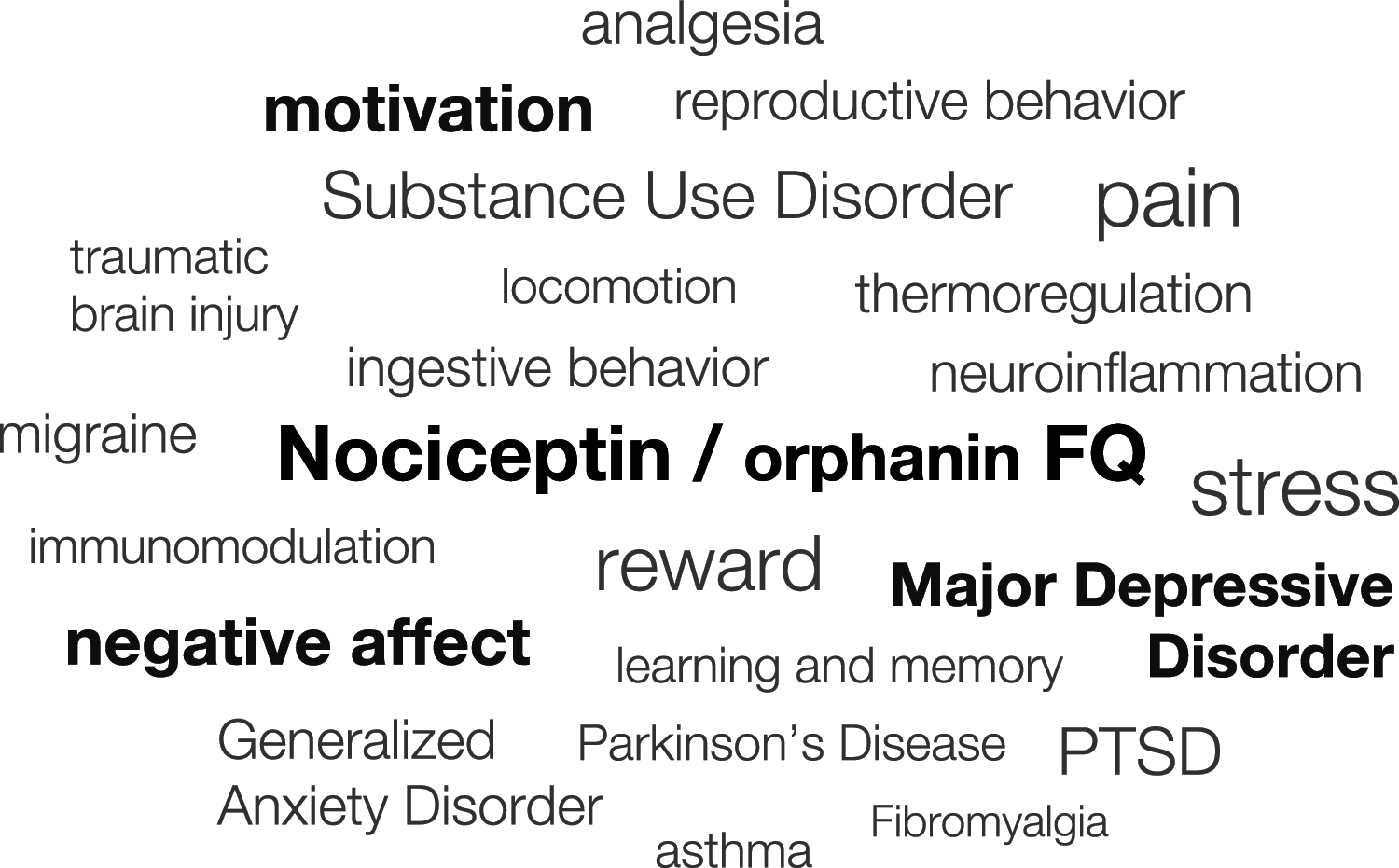Pain, Motivation, Migraine, and the Microbiome: New Frontiers for Opioid Systems and Disease
- PMID: 32958571
- PMCID: PMC7562975
- DOI: 10.1124/mol.120.119438
Pain, Motivation, Migraine, and the Microbiome: New Frontiers for Opioid Systems and Disease
Abstract
For decades the broad role of opioids in addiction, neuropsychiatric disorders, and pain states has been somewhat well established. However, in recent years, with the rise of technological advances, not only is the existing dogma being challenged, but we are identifying new disease areas in which opioids play a critical role. This review highlights four new areas of exploration in the opioid field. The most recent addition to the opioid family, the nociceptin receptor system, shows promise as the missing link in understanding the neurocircuitry of motivation. It is well known that activation of the kappa opioid receptor system modulates negative affect and dysphoria, but recent studies now implicate the kappa opioid system in the modulation of negative affect associated with pain. Opioids are critical in pain management; however, the often-forgotten delta opioid receptor system has been identified as a novel therapeutic target for headache disorders and migraine. Lastly, changes to the gut microbiome have been shown to directly contribute to many of the symptoms of chronic opioid use and opioid related behaviors. This review summarizes the findings from each of these areas with an emphasis on identifying new therapeutic targets. SIGNIFICANCE STATEMENT: The focus of this minireview is to highlight new disease areas or new aspects of disease in which opioids have been implicated; this includes pain, motivation, migraine, and the microbiome. In some cases, this has resulted in the pursuit of a novel therapeutic target and resultant clinical trial. We believe this is very timely and will be a refreshing take on reading about opioids and disease.
Copyright © 2020 by The American Society for Pharmacology and Experimental Therapeutics.
Figures




Similar articles
-
Biased Opioid Ligands.Molecules. 2020 Sep 16;25(18):4257. doi: 10.3390/molecules25184257. Molecules. 2020. PMID: 32948048 Free PMC article. Review.
-
Alleviating pain with delta opioid receptor agonists: evidence from experimental models.J Neural Transm (Vienna). 2020 Apr;127(4):661-672. doi: 10.1007/s00702-020-02172-4. Epub 2020 Mar 18. J Neural Transm (Vienna). 2020. PMID: 32189076 Review.
-
Forebrain delta opioid receptors regulate the response of delta agonist in models of migraine and opioid-induced hyperalgesia.Sci Rep. 2020 Oct 19;10(1):17629. doi: 10.1038/s41598-020-74605-9. Sci Rep. 2020. PMID: 33077757 Free PMC article.
-
Evidence for nociceptin/orphanin FQ (NOP) but not µ (MOP), δ (DOP) or κ (KOP) opioid receptor mRNA in whole human blood.Br J Anaesth. 2016 Mar;116(3):423-9. doi: 10.1093/bja/aev540. Br J Anaesth. 2016. PMID: 26865135
-
Opioid Receptors.Annu Rev Med. 2016;67:433-51. doi: 10.1146/annurev-med-062613-093100. Epub 2015 Aug 26. Annu Rev Med. 2016. PMID: 26332001 Review.
Cited by
-
Chronic opioid use modulates human enteric microbiota and intestinal barrier integrity.Gut Microbes. 2021 Jan-Dec;13(1):1946368. doi: 10.1080/19490976.2021.1946368. Gut Microbes. 2021. PMID: 34313547 Free PMC article.
-
Ro 64-6198, a selective NOP receptor agonist attenuates social impairments associated with NTG-induced migraine pain.Neuropsychopharmacology. 2025 Aug 14. doi: 10.1038/s41386-025-02187-z. Online ahead of print. Neuropsychopharmacology. 2025. PMID: 40813451
-
The life and times of endogenous opioid peptides: Updated understanding of synthesis, spatiotemporal dynamics, and the clinical impact in alcohol use disorder.Neuropharmacology. 2023 Mar 1;225:109376. doi: 10.1016/j.neuropharm.2022.109376. Epub 2022 Dec 11. Neuropharmacology. 2023. PMID: 36516892 Free PMC article. Review.
-
Editorial: 50 Years of Opioid Research and the International Narcotics Research Conference.Mol Pharmacol. 2020 Oct;98(4):386-388. doi: 10.1124/molpharm.120.000132. Epub 2020 Aug 12. Mol Pharmacol. 2020. PMID: 32788221 Free PMC article.
-
Kratom Alkaloids as Probes for Opioid Receptor Function: Pharmacological Characterization of Minor Indole and Oxindole Alkaloids from Kratom.ACS Chem Neurosci. 2021 Jul 21;12(14):2661-2678. doi: 10.1021/acschemneuro.1c00149. Epub 2021 Jul 2. ACS Chem Neurosci. 2021. PMID: 34213886 Free PMC article.
References
-
- Acharya C, Betrapally NS, Gillevet PM, Sterling RK, Akbarali H, White MB, Ganapathy D, Fagan A, Sikaroodi M, Bajaj JS. (2017) Chronic opioid use is associated with altered gut microbiota and predicts readmissions in patients with cirrhosis. Aliment Pharmacol Ther 45:319–331. - PubMed
-
- Aldrich JV, Vigil‐Cruz SC. (2003) Narcotic analgesics, Burger’s Medicinal Chemistry and Drug Discovery pp 331–482, Wiley, New York.
-
- American Psychiatric Association (2013) Diagnostic and Statistical Manual of Mental Disorders: DSM-5, 5th ed, American Psychiatric Association, Washington, D.C..
Publication types
MeSH terms
Substances
Grants and funding
LinkOut - more resources
Full Text Sources
Medical

